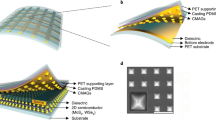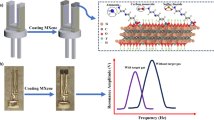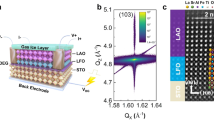Abstract
Semiconducting metal oxides are widely used for gas sensors. The resulting chemiresistor devices, however, suffer from non-linear responses, signal fluctuations and gas cross-sensitivities, which limits their use in demanding applications of air-quality monitoring. Here, we show that conventional semiconducting metal oxide materials can provide high-performance sensors using an impedance measurement technique. Our approach is based on dielectric excitation measurements and yields sensors with a linear gas response (R2 > 0.99), broad dynamic range of gas detection (six decades of concentrations) and high baseline stability, as well as reduced humidity and ambient-temperature effects. We validated the technique using a range of commercial sensing elements and a range of gases in both laboratory and field conditions. Our approach can be applied to both n- and p-type semiconducting metal oxide materials, and we show that it can be used in wireless sensor networks, and drone-based and wearable environmental and industrial gas monitoring.
This is a preview of subscription content, access via your institution
Access options
Access Nature and 54 other Nature Portfolio journals
Get Nature+, our best-value online-access subscription
$29.99 / 30 days
cancel any time
Subscribe to this journal
Receive 12 digital issues and online access to articles
$119.00 per year
only $9.92 per issue
Buy this article
- Purchase on Springer Link
- Instant access to full article PDF
Prices may be subject to local taxes which are calculated during checkout






Similar content being viewed by others
Data availability
The data that support the plots within this paper and other findings of this study are available from the corresponding author upon reasonable request.
References
Lewis, A. & Edwards, P. Validate personal air-pollution sensors. Nature 535, 29–31 (2016).
Kalantar-Zadeh, K. et al. A human pilot trial of ingestible electronic capsules capable of sensing different gases in the gut. Nat. Electron. 1, 79–87 (2018).
Nugroho, F. A. et al. Metal–polymer hybrid nanomaterials for plasmonic ultrafast hydrogen detection. Nat. Mater. 18, 489–495 (2019).
van den Broek, J., Abregg, S., Pratsinis, S. E. & Güntner, A. T. Highly selective detection of methanol over ethanol by a handheld gas sensor. Nat. Commun. 10, 4220 (2019).
Tao, N. Challenges and promises of metal oxide nanosensors. ACS Sens. 4, 780–780 (2019).
Williams, D. E. Low cost sensor networks: how do we know the data are reliable? ACS Sens. 4, 2558–2565 (2019).
Hunter, G. W. et al. Editors’ choice—critical review—a critical review of solid state gas sensors. J. Electrochem. Soc. 167, 037570 (2020).
Ihokura, K. & Watson, J. Stannic Oxide Gas Sensor: Principles and Applications (CRC, 1994).
Staerz, A., Suzuki, T., Weimar, U. & Barsan, N. in Tin Oxide Materials (ed. Orlandi, M. O.) 345–377 (Elsevier, 2020).
Rüffer, D., Hoehne, F. & Bühler, J. New digital metal-oxide (MOx) sensor platform. Sensors 18, 1052 (2018).
Finkbeiner, S. Keynote: How Software Makes MEMS Sensors into Smart Systems MEMS & Sensors Executive Congress MSEC 2019, San Diego, CA, October 22–24 (MSIG, 2019).
Cipriano, D. & Capelli, L. Evolution of electronic noses from research objects to engineered environmental odour monitoring systems: a review of standardization approaches. Biosensors 9, 75 (2019).
Clifford, P. K. & Tuma, D. T. Characteristics of semiconductor gas sensors I. Steady state gas response. Sens. Actuators 3, 233–254 (1982).
Gurlo, A., Barsan, N., Ivanovskaya, M., Weimar, U. & Göpel, W. In2O3 and MoO3–In2O3 thin film semiconductor sensors: interaction with NO2 and O3. Sens. Actuators B 47, 92–99 (1998).
Barsan, N. & Weimar, U. Conduction model of metal oxide gas sensors. J. Electroceram. 7, 143–167 (2001).
Yamazoe, N. & Shimanoe, K. Theory of power laws for semiconductor gas sensors. Sens. Actuators B 128, 566–573 (2008).
Tricoli, A., Graf, M. & Pratsinis, S. E. Optimal doping for enhanced SnO2 sensitivity and thermal stability. Adv. Funct. Mater. 18, 1969–1976 (2008).
Kamble, V. B. & Umarji, A. M. Achieving selectivity from the synergistic effect of Cr and Pt activated SnO2 thin film gas sensors. Sens. Actuators B 236, 208–217 (2016).
Hua, Z., Li, Y., Zeng, Y. & Wu, Y. A theoretical investigation of the power-law response of metal oxide semiconductor gas sensors Ι: Schottky barrier control. Sens. Actuators B 255, 1911–1919 (2018).
Urasinska-Wojcik, B. & Gardner, J. W. H2S sensing in dry and humid H2 environment with p-type CuO thick-film gas sensors. IEEE Sens. J. 18, 3502–3508 (2018).
Izawa, K., Ulmer, H., Staerz, A., Weimar, U. & Barsan, N. in Gas Sensors Based on Conducting Metal Oxides: Basic Understanding, Technology and Applications (eds Barsan, N. & Schierbaum, K.) 217–257 (Elsevier, 2019).
Degler, D., Weimar, U. & Barsan, N. Current understanding of the fundamental mechanisms of doped and loaded semiconducting metal oxide-based gas sensing materials. ACS Sens. 4, 2228–2249 (2019).
Ngai, K. L., Jonscher, A. K. & White, C. T. On the origin of the universal dielectric response in condensed matter. Nature 277, 185–189 (1979).
Weimar, U. & Göpel, W. A. C. Measurements on tin oxide sensors to improve selectivities and sensitivities. Sens. Actuators B 26, 13–18 (1995).
Bueno, P. R., Varela, J. A. & Longo, E. Admittance and dielectric spectroscopy of polycrystalline semiconductors. J. Eur. Ceram. Soc. 27, 4313–4320 (2007).
Su, Y. et al. Pd-loaded SnO2 hierarchical nanospheres for a high dynamic range H2S microsensor. RSC Adv. 9, 5987–5994 (2019).
Chakraborty, S., Sen, A. & Maiti, H. S. Complex plane impedance plot as a figure of merit for tin dioxide-based methane sensors. Sens. Actuators B 119, 431–434 (2006).
Barsan, N. & Weimar, U. Understanding the fundamental principles of metal oxide based gas sensors; the example of CO sensing with SnO2 sensors in the presence of humidity. J. Phys. Condens. Matter 15, R813–R839 (2003).
Wicker, S., Guiltat, M., Weimar, U., Hémeryck, A. & Barsan, N. Ambient humidity influence on CO detection with SnO2 gas sensing materials. A combined DRIFTS/DFT investigation. J. Phys. Chem. C 121, 25064–25073 (2017).
Zhu, H. et al. A new insight into cross‐sensitivity to humidity of SnO2 sensor. Small 14, 1703974 (2018).
Wang, J. et al. The effect of humidity on the dielectric properties of (In + Nb) co-doped SnO2 ceramics. J. Eur. Ceram. Soc. 39, 323–329 (2019).
Mallires, K. R., Wang, D., Tipparaju, V. V. & Tao, N. Developing a low-cost wearable personal exposure monitor for studying respiratory diseases using metal oxide sensors. IEEE Sens. J. 19, 8252–8261 (2019).
Collier-Oxandale, A. M., Thorson, J., Halliday, H., Milford, J. & Hannigan, M. Understanding the ability of low-cost MOx sensors to quantify ambient VOCs. Atmos. Meas. Tech. 12, 1441–1460 (2019).
Li, W., Short, J. D. & Possin, G. E. Apparatus for reducing photodiode thermal gain coefficient. US patent 8,564,086 (2013).
Vlasov, Y., Green, W. M. & Xia, F. High-throughput silicon nanophotonic wavelength-insensitive switch for on-chip optical networks. Nat. Photon. 2, 242–246 (2008).
Middlemiss, R. et al. Measurement of the earth tides with a MEMS gravimeter. Nature 531, 614–617 (2016).
Jonscher, A. K. Physical basis of dielectric loss. Nature 253, 717–719 (1975).
Booksh, K. S. & Kowalski, B. R. Theory of analytical chemistry. Anal. Chem. 66, 782A–791A (1994).
Potyrailo, R. A. Multivariable sensors for ubiquitous monitoring of gases in the era of internet of things and industrial internet. Chem. Rev. 116, 11877–11923 (2016).
Schipani, F. et al. Electrical characterization of semiconductor oxide-based gas sensors using impedance spectroscopy: a review. Rev. Adv. Sci. Eng. 5, 86–105 (2016).
Schierbaum, K. D., Weimar, U. & Göpel, W. Multicomponent gas analysis: an analytical chemistry approach applied to modified SnO2 sensors. Sens. Actuators B 2, 71–78 (1990).
Gilliam, J. H. & Hall, E. S. Reference and Equivalent Methods Used to Measure National Ambient Air Quality Standards (NAAQS) Criteria Air Pollutants Vol. I EPA/600/R-16/139 (US EPA Office of Research and Development National Exposure Research Laboratory, 2016).
Lewis, A. C., von Schneidemesser, E. & Peltier, R. E. Low-Cost Sensors for the Measurement of Atmospheric Composition: Overview of Topic and Future Applications WMO no. 1215 (World Meteorological Organization, 2018).
Fortenberry, C. et al. Analysis of indoor particles and gases and their evolution with natural ventilation. Indoor Air 29, 761–779 (2019).
Wang, J. et al. Belt-mounted micro-gas-chromatograph prototype for determining personal exposures to volatile-organic-compound mixture components. Anal. Chem. 91, 4747–4754 (2019).
Potyrailo, R. A. Toward high value sensing: monolayer-protected metal nanoparticles in multivariable gas and vapor sensors. Chem. Soc. Rev. 46, 5311–5346 (2017).
Potyrailo, R. A. et al. Towards outperforming conventional sensor arrays with fabricated individual photonic vapour sensors inspired by Morpho butterflies. Nat. Commun. 6, 7959 (2015).
Potyrailo, R. A. et al. Discovery of the surface polarity gradient on iridescent Morpho butterfly scales reveals a mechanism of their selective vapor response. Proc. Natl Acad. Sci. USA 110, 15567–15572 (2013).
Potyrailo, R. A., Karker, N., Carpenter, M. A. & Minnick, A. Multivariable bio-inspired photonic sensors for non-condensable gases. J. Opt. 20, 024006 (2018).
Potyrailo, R. A. et al. Multi-gas sensors for enhanced reliability of SOFC operation. ECS Trans. 91, 319–328 (2019).
Cortes, C. & Vapnik, V. Support-vector networks. Mach. Learn. 20, 273–297 (1995).
Martens, H. & Martens, M. Multivariate Analysis of Quality. An Introduction (Wiley, 2001).
Rifkin, R. & Klautau, A. In defense of one-vs-all classification. J. Mach. Learn. Res. 5, 101–141 (2004).
Ingle, J. D. Jr & Crouch, S. R. Spectrochemical Analysis (Prentice Hall 1988).
Acknowledgements
Different phases of this project were funded by GE Research Innovation Fund, GE Services, National Institute for Occupational Safety and Health Contracts 211-2015-63806 and 75D30118C02617, GE Renewable Energy and BHGE. The findings and conclusions in this study should not be construed to represent any determination or policy of the US Government. The content of this report does not necessarily reflect the position or the policy of the US Government. Certain commercial equipment, instruments or materials are identified in this paper to foster understanding. Such identification does not imply recommendation or endorsement by the National Institute for Occupational Safety and Health and the National Institute of Standards and Technology, nor does it imply that the materials or equipment identified are necessarily the best available for the purpose.
Author information
Authors and Affiliations
Contributions
R.A.P. conceived and led the research, R.A.P., C.C. and N.A. designed the laboratory and field experiments, R.A.P., S.G., B.A. and R.S.-P. developed the experimental set-ups for the laboratory tests, S.G., D.S., B.A. and R.S.-P. designed the wireless sensor nodes, A.K. designed and performed the nanocharacterization experiments, R.A.P., S.G., N.A., D.F., C.M. and P.M. performed laboratory and field experiments, X.L. and C.C.-D. performed the theoretical modelling, M.N., G.W. and R.A.P. analysed field data from the sensor nodes, R.A.P. and B.S. analysed data from the multigas experiments and R.A.P. wrote the manuscript with input and comments from all the authors.
Corresponding author
Ethics declarations
Competing interests
The authors declare no competing interests.
Additional information
Publisher’s note Springer Nature remains neutral with regard to jurisdictional claims in published maps and institutional affiliations.
Extended data
Extended Data Fig. 1 Spectral details of dielectric excitation measurements of response of a SMOX sensing element to different concentration ranges of methane.
a, 0–10 ppm, b, 0–100 ppm, c, 0–1,000 ppm, and d, 0–10,000 ppm. Each panel (a–d) has the top graph of Z′(f) spectra, middle graph of Z″(f) spectra and the bottom graph is the zoomed-in region of Z″(f) spectra with the spectral region of the linear sensor response to methane (dotted lines). Different colors in spectra in (a–d) are labeled as 0 to 16 as the respective methane gas concentration steps depicted in Fig. 1g–n and plotted as a blank (0) and every other spectrum (2–16).
Extended Data Fig. 2 Broad range of gas-response linearity achieved with dielectric excitation measurements.
a, Detection of methane at sub-ppm and low-ppm concentrations with the achieved LOD of 0.02 ppm. b, Detection of methane from 0 to 11 % vol.
Extended Data Fig. 4 Dielectric excitation measurements with a p-type SMOX material using a VOCM31 sensing element (see Supplementary Table 1).
Ethanol was used as a model analyte. Monitoring of ethanol concentrations using a, conventional resistance and b, dielectric excitation measurements. c, Z′(f) and d, Z″(f) spectra and e, Nyquist plots of sensor response. f, Frequency dependence of the R2 values of the linear fit. Inset, low-frequency range. Ethanol vapour concentrations: 0, 300, 600, 900, 1200, 1500, and 1800 ppm. For details about the VOCM31 sensing element (see Supplementary Table 1).
Extended Data Fig. 5 Rules for dielectric excitation measurements to achieve linear gas-sensing response in n- and p-type SMOX materials.
a, Response of n-type materials to increasing concentrations of reducing volatiles where Z″(f) spectra follow the increasing gas concentrations with the high-frequency shifts. b, Response of p-type materials to increasing concentrations of reducing volatiles where Z″(f) spectra follow the increasing gas concentrations with the low-frequency shifts. Thus, for both, n- and p-type SMOX materials the linear Z″(f) gas responses were observed on the front-edge shoulder of the relaxation peak that followed the gas concentrations. For n- and p-type materials, the front-edge shoulder was the high- or low-frequency regions of the relaxation peak, respectively.
Extended Data Fig. 6 Dynamic response of the SMOX-based sensor in different modes of operation.
a, Conventional chemiresistor mode, b, Dielectric excitation measurement mode.
Extended Data Fig. 7 Wireless sensor node components and field data collection unit.
a, Boards for sensor data acquisition, b, Boards for sensor data acquisition and wireless data communication. c, Assembled sensor node. d, Sensor nodes in a chamber for gas calibration. e, Field data collection unit, paper coffee cup shown for scale.
Extended Data Fig. 8 Benchmarking of the performance of the developed wireless sensor node against a tunable diode laser absorption spectroscopy (TDLAS) system in dynamic detection of methane under ambient wind conditions.
a, Test layout. Dynamic responses of b, TDLAS and c, developed sensor system.
Extended Data Fig. 9 Summary of calibration stability of several sensor nodes after 407 days as percent of sensitivity change of the sensors.
a, b, Z′ measurements and histogram for all nodes. c, d, Z″ measurements and histogram for all nodes. e, Summary for all nodes demonstrating Z′ calibration stability from–3% to 3% and Z″ calibration stability from – 15% to - 3%. Node 7 was not tested.
Supplementary information
Supplemental Information
Supplementary Notes 1–9, Tables 1–3, Figs. 1–29 and references 1–151.
Rights and permissions
About this article
Cite this article
Potyrailo, R.A., Go, S., Sexton, D. et al. Extraordinary performance of semiconducting metal oxide gas sensors using dielectric excitation. Nat Electron 3, 280–289 (2020). https://doi.org/10.1038/s41928-020-0402-3
Received:
Accepted:
Published:
Issue Date:
DOI: https://doi.org/10.1038/s41928-020-0402-3
This article is cited by
-
Wide-range soft anisotropic thermistor with a direct wireless radio frequency interface
Nature Communications (2024)
-
A broad-spectrum gas sensor based on correlated two-dimensional electron gas
Nature Communications (2023)
-
Additively manufactured magic cube platforms for fully integrated wireless sensing nodes for Internet of Things applications
Scientific Reports (2023)
-
Air pollution forecasting based on wireless communications: review
Environmental Monitoring and Assessment (2023)
-
A customizable, low-power, wireless, embedded sensing platform for resistive nanoscale sensors
Microsystems & Nanoengineering (2022)



